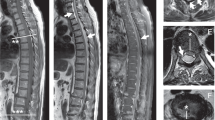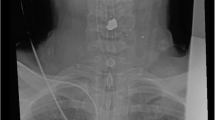Abstract
Objective:
To report on an unusual knife stab injury of the thoracic spine, causing an acute subdural haematoma (SDH) and paraparesis.
Setting:
Department of Surgical Neurology, Ward 20, The Royal Infirmary of Edinburgh.
Case report:
The weapon was a knife, which traversed the mid-thoracic spinal region, causing an incomplete spinal cord lesion, which was demonstrated by myelography to be due to an SDH. The haematoma was removed at operation. There was a full neurological recovery.
Conclusion:
There was no bony injury. The likely cause for the development of the SDH was believed to be due to the sudden impingement on the spine by the weapon, rupturing small subdural veins.
Similar content being viewed by others
Introduction
An acute traumatic SDH causing a significant spinal cord lesion is rare, especially in the absence of an antecedent history of a blood dyscrasia, or of taking an anticoagulant drug. Such a case is now reported.
Case report
A 15-year-old youth was involved in a fracas in Edinburgh. A boy struck him on his back with a knife causing the youth to fall down. He had acute pain in his back and had difficulty in moving his legs. He was taken forthwith to the Department of Surgical Neurology, Royal Infirmary of Edinburgh, coming under my care. The weapon had been removed; blood loss appeared to have been minimal. There was a small vertical clean cut skin wound, some 5 cm in length in the centre of the mid-thoracic region. There was no leakage of cerebrospinal fluid (CSF) and no evidence of any other injuries. He had a partial Brown–Sequard type of neurological disturbance. The neural level was at T9–T10, with grade 2 motor power in the right and grade 4 in the left leg. Tone was reduced in the legs. Lower abdominal and cremasteric reflexes were absent. Right plantar response extensor; left equivocal. Right knee and ankle jerks and left knee jerks were depressed. Anal sphincter tone was normal. Pain, temperature and tickle sensation were reduced in the legs. Imaging studies were as follows: (a) plain radiographs of the spine: these were normal. (b) Lumbar myelography revealed an intradural mass at the T7–T8 level, compressing the spinal cord to the left; there was a complete spinal block. (The CSF was later reported to be normal). (It is to be noted that neither CT nor MRI scanning were available in the hospital then.) We ensured that the patient had not been, prior to the injury, on any anticoagulant drug, nor did he have a coagulation disorder. These, if present, could be possible factors in the production of the SDH.1, 2
Emergency surgery was carried out. The back wound was excised, and was traced toward the bony spine, through muscles and other soft tissues. There was no evidence of any injury to bone. A laminectomy of T7 and T8 vertebrae revealed a tense, nonpulsating dura, purple and bulging. The dura was now opened to reveal a discrete, semisolid haematoma, displacing the spinal cord to the left. With suction and irrigation the SDH was removed. Apart from the effect of compression by the SDH, the spinal cord was noted to be normal. There was no evidence of a vascular lesion, such as an arteriovenous anomaly. CSF now passed fully up and down in the subarachnoid space. Routine wound closure was made. With good physiotherapy, the patient made a complete neurological recovery.
The police subsequently presented me with the weapon that was used, a clasp knife, which was 18.5 cm long, fully opened, with a blade 7.5 cm in length (Figure 1).
Discussion
Knowledge of the anatomy of the thoracic spine region is necessary to allow us to consider the possible or probable effects of a knife stab, causing an acute SHD. The thoracic laminae are imbricated; therefore, for a knife – if not too wide in the blade – to enter the thoracic spinal canal, it would require to have been driven upwards and to one side of the midline, and in an oblique direction.3, 4, 5, 6, 7 However, in the case of the patient there was no radiological evidence of penetration by the knife into the spinal canal; this was confirmed during the neurosurgical operation.
The presence of vessels, and in particular veins, in the subdural space has been described by Djindjian et al8 in their important studies. They noted the presence of small vessels in the subdural space. Manelfe,9 quoted by Russell and Benoit,2 found an anastomatic network in the spine, of very delicate vessels subdurally along the lateral margins of the undersurface of the duramater; however, it was felt that their small size made them an unlikely source of haemorrhage. Weinstein10 noted that there were occasional bridging veins from the spinal cord PIA to the spinal cord.
The actual mechanism for the development of an acute thoracic SDH is a subject of conjecture, certainly in the present case of the 15-year-old boy. It could be possible that the acute, severe, localised blow with the strong knife caused a sudden surge and rise of intravascular pressure, with the rupture of small subdural veins, resulting in the production of SDH. This view is also entertained by Djindjian et al,8 and by Wilkins.7 The case of Zilkha and Nicolette11 is of interest. He reports on a 26-year-old lady who had a febrile illness and a scalp abscess, and sustained a minor fall on her back. In the following week there was a gradual onset of weakness and sensory changes in her legs. Myelography showed a possible L2–L5 vertebral spinal epidural abscess, but at operation a subdural clot was found, and histological examination of it revealed an organising thrombus. However, the mechanism and the history of the SDH differ from that of the patient we discuss. A ‘pure’ acute intracranial SDH is a rarity: a history of a severe closed head injury, with multiple pathologies – laceration of vessels, probably including some large cortical veins crossing in the subdural space to enter the superior longitudinal sinus, laceration and swelling of the brain, and also often, intracerebral haemorrhages and a very ill head injury patient. All are very different from an acute spinal SDH.12
The Brown–Sequard type of syndrome is a common feature of reported cases of acute thoracic SDH, indeed in 70–80% of cases, resulting from a variety of aetiologies.3, 4, 5, 6, 9, 10, 13 Emergency surgery is mandatory once a diagnosis has been speedily made.4, 5
In all reported series, if there is an incomplete spinal cord lesion the outcome with prompt treatment is excellent, often with full neurological recovery. However, if there is complete paraplegia, full recovery is unlikely. It would appear to be timely to relate the case of this youth, who was involved in a knife crime, as unfortunately such vicious attacks are becoming more common.
(Note: Permission to refer to the leading article in the Brit Med J 1978, 1: 1093–1094 ‘Stab wounds of the spinal cord’ was given by the BMJ Publishing Group).
References
Miller DR, Ray AH . Spinal subdural haematoma: how relevant is the INR? Spinal Cord 2004; 42: 477–480.
Russell NA, Benoit BG . Spinal subdural haematoma: A review. Surg Neurol 1983; 20: 133–137.
Cowie RA . Spinal subdural haematoma. In: Findlay G, Owen R (eds). Surgery of the Spine Vol. 2 Blackwell Scientific Publications: Oxford 1992, p 825.
Harris P . Stab wounds of the spinal cord. Leading article. Br Med J 1978; 1: 1093–1094.
Lipschitz R, Block J . Stab wounds of the spinal cord. Lancet 1962; 28: 169–172.
Lipschitz R . Stab wounds of the spinal cord. In: Vinken RJ, Bruyn GU (eds). Handbook of Clinical Neurology. North-Holland Publishing: Amsterdam 1976.
Wilkins RH . Spinal subdural haematomas. In: Wilkins RH, Rengachary SS (eds). Neurosurgery Vol. 2 McGraw-Hill Books: New York.
Djindjian R et al. Angiography of the Spinal Cord. University Park Press: Baltimore, MD 1970.
Manelfe C . Contribution a l'eude de la vascularisation arterielle de la dura-mere rachidienne chez l'homme: Etude anatomico-radiologique considerations pathologiques. Toulouse Imprimare Fournie 1969. cited by Edelson RN. Spinal subdural hematomas. In: Vuikes PI (ed). Handbook of Clinical Neurology Vol. 36. Injuries of the Spine and Spinal Cord. Part II. Amsterdam: North Holland 1976, pp 31–38.
Weinstein PR . In: Guthikonda M, Schmidek WH, Wallman LJ et al. Spinal Subdural Haematoma Case Report and Review of the literature. Neurosurgery 1979; 5(part 5): 614–616.
Zilkha A, Nicolette JM . Acute spinal subdural haematoma. Case Report. J Neurosurg 1974; 41: 627–630.
Harris P . Acute traumatic subdural haematomas: results of the neurosurgical care. In: Head Injuries. Proceedings of an International Symposium held in Edinburgh and Madrid. Churchill Livingstone: Edinburgh 1971, pp 321–326.
Waters RL, Sie J, Adkins RH, Yakura JS . Motor recovery following Spinal cord injury caused by stab wounds. Paraplegia 1995; 33: 98–101.
Author information
Authors and Affiliations
Rights and permissions
About this article
Cite this article
Harris, P. Stab wound of the back causing an acute subdural haematoma and a Brown–Sequard neurological syndrome. Spinal Cord 43, 678–679 (2005). https://doi.org/10.1038/sj.sc.3101765
Published:
Issue Date:
DOI: https://doi.org/10.1038/sj.sc.3101765




